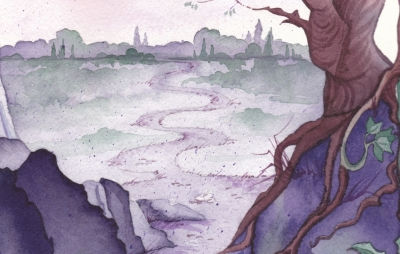A symbol is “like a mirror swinging out from the mind, able to look back on itself.” In symbols, we can step back from life and see it objectively. We can look back at where we are and where we have been.
Joseph Campbell is, perhaps, most famous for his advice “follow your bliss.” In his interviews with Bill Moyers (1985-1986), Campbell said, “…if you do follow your bliss, you put yourself on a kind of track that has been there all the while, waiting for you, and the life that you ought to be living is the one you are living” (Campbell, 1988, p. 120).
The idea that we should follow our bliss and realize our potentials resonates deeply for most of us. We want our lives to have meaning and purpose. However, finding our bliss is not always easy, especially in a technological, consumer-oriented world were we are bombarded with messages about what we should have, be, and do. It’s very difficult to filter out the environmental static so that we can hear the melody of our own song.
The Marga Path
Given that we live in a world filled with distractions, marketing, and other psychological manipulations, how do we follow Campbell’s advice, how do we find our bliss? How do we define and pursue our own personal myth and know what is real and true in our lives? While there is no simple answer to this question, Campbell, in his writing and his lectures, suggested how we might get started. In a discussion of marga, the Hindu path to liberation, he writes,
 “…the way to find your own myth is to find those traditional symbols that speak to you, to use them, you might say, as bases for meditation. …Let the symbols play upon the imagination, act upon the imagination, and bring your own imagination into play in relation to these [symbols] and then you will be experiencing the marga or the power of these symbols to open things up for you” (Campbell, 2011).
“…the way to find your own myth is to find those traditional symbols that speak to you, to use them, you might say, as bases for meditation. …Let the symbols play upon the imagination, act upon the imagination, and bring your own imagination into play in relation to these [symbols] and then you will be experiencing the marga or the power of these symbols to open things up for you” (Campbell, 2011).
I think it’s important that we look at the wording Campbell chooses. He said “let the symbols play” on your imagination and “bring your imagination into play” in relation to the symbols. In other words, the symbols speak to us and we speak to the symbols in a dialogical, hermeneutic process.
First you find symbols that resonate for you or that, at some level, have “felt” rather than intellectual meaning. Then you explore those symbols and allow them to germinate in your mind. Finally, you let your imagination play with the symbols, manipulating them, exploring different relationships and order. This process opens a “dialog” between you and the symbols, and through that dialogue, new meaning emerges. That revealed meaning, the message of the symbols, will give you clues to your own mythology, the meaning of your own journey and the source of your bliss.
In her book Life’s Companion: Journal Writing as a Spiritual Quest, Christina Baldwin describes the process in terms of writing:
When we take up the pilgrimage, consciousness emerges in an on-going, intimate dialog within the self. Once awakened, we are aware of and intrigued by the processes of our own minds. Some people speak of becoming conscious as a moment of mental fusion, or a reflecting capacity — like a mirror swinging out from the mind, able to look back on itself (1990, p. 8).
Self Mirrored in Symbols
The key metaphor here is, I think, the “mirror swinging out from the mind, able to look back on itself.” I read somewhere long ago that if we want to truly see where we are, we have to go somewhere else and look back. I think that this process of looking back at ourselves to see where we are, whether through writing or symbols, is what Campbell means. In an interview with Michael Toms (1988), Campbell spoke of the yidam (a meditational or protective deity in Eastern philosophy) as a symbolic figure that “has no concrete reality except as a carrier, a mirror of your own psychological potentials” (p. 93).
The symbol becomes a mirror in which we can explore our own mythology. By using the symbols we can step away from our lives for a moment and look back at where we have been. Through that process, we can discover the subconscious myths that are currently informing and shaping our lives. By finding, exploring and working with resonating symbols, we can begin the process of defining and realizing our potentials. From there, from the knowledge of who we are and who we can be, we can discover the path which will allow us, as Campbell encouraged, to follow our bliss.
Copyright © 2013 by Reg Harris. All rights reserved. Apart from properly cited quotes and short excerpts, no part of this article can be copied or used in any form, including posting on the Internet, without written permission from the author. Any such unauthorized use is a violation of the Digital Millennium Copyright Act (DMCA). For permission, contact Reg Harris.
References
Baldwin, C. (1990). Life’s Companion: Journaly Writing as a Spiritual Quest. New York: Bantam.
Campbell, J. (1988). The Power of Myth. New York: Doubleday.
Campbell, J. (2011). Personal Myth [CD]. San Anselmo, CA: Joseph Campbell Foundation.
Toms, M. (1988). An Open Life: Joseph Campbell in Conversation with Michael Toms. (Maher, J. and D. Briggs, eds.) Burdett, NY: Larson Publications.
